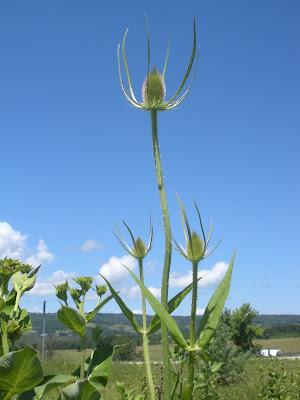The day is warm but not hot, the sun is at its peak and everything in nature is in harmonic rhythm growing, blooming, doing "its thing."
Summer, it seems to me, is the time for heat, humidity and colour. Colours that range from soft as in the fuscia, white and lime green of the milkweed (seen here) to flashes of orange, hot pink, yellow, blue.
Summer colours are rich, not the soft awakening mists of spring, but bold and expectant, beginning to be fruitful in the true meaning of the word.
Knapweed has spread throughout the pasture - looking a bit like caesarea, and called by some wild beramot. But its soft fuzzy violent violet heads remind me of brushes dipped into a hot coloured bucket of paint and left out to dry - all different shapes as it matures to the beige-brown seed heads ready to spread throughout the grass for scavenging birds, mice, moles and other seed-eaters.
Birdsfoot trefoil adds motes of sunshine to the greens of grasses, sedges and other legumes. When mown, it forms brilliant clumps of cheerful flowers before they turn into seed pods that look indeed like bird feet.
Purple vetch weaves its lacey fronds throughout the pasture and gardens too when it can get a toehold.
I had thought these to be Beggarsticks - but they are not. So I'm searching for their name. They are spreading in the pasture and the birds seem to like the seeds... very tall... If you know could you put the name in the comments form at the bottom please? My book of weeds is packed away ready for moving, and I haven't figured out how to use a photo to track down stuff on the internet yet. Maybe that's something someone can teach me as well? But the flowers are beautiful - a cross between coreopsis and sunflowers perhaps - cheerfully nodding in the landscape.
The silvery green of a maturing teasel spike is set off by the hot blue of a summer sky beyond. Before long the soft pale purple on the heads will become tiny flowers and then form seeds for European finches. Like many weeds and flowers found in North America now, this is considered an invasive species when it spreads to form a spiny forest blocking the growth of native species... but it's used by many in flower arrangements and with those spines, could probably be used as a comb for combing out wools? What do you think?
No need to identify this cheerful wildflower ubiquitous throughout the world I suspect and the namesake for dogs, other pets and people as well. It is a member of the sunflower/aster family and comes in many cultivated varieties.
A tangle of wild sweet peas graces the edge of an entrance to a farm property.
Like many of the wildflowers shown here the tiger lily edges ditches, pops up in gardens, flourishes along the edge of abandoned buildings - lending hot colour to the greens of summer.
And finally not a wildflower, but a sea of blue - flax that is seen briefly in summer, more often now that flax has been identified as a "healthy" product. To me it's healthy for the eyes - just to see it... a delight and feast!
Summer's colours range from soft to hot. In northern climes and probably in places like New Zealand which also experiences seasonal changes and gets snow and ice, the colour is very welcome after our cold months. Just the thought of colour sometimes can warm chilly bones. And while I personally prefer the gentle softness of spring colours when everything is becoming breathtakingly fresh and renewed, summer's nodding wildflowers are their own treasure that I enjoy on drives and walks. Aren't we lucky?
May you enjoy some wildflower gifts today - in a bouquet, in a field, by the roadside or river - images of long lazy summer days. I can almost hear the bees buzzing, can you?










You've really captured summer here Barbara! I now feel as if I live next door to you in Ontario! Such a wonderful place to live and see the natural world. You are one lucky lady! This was beautiful!
ReplyDelete